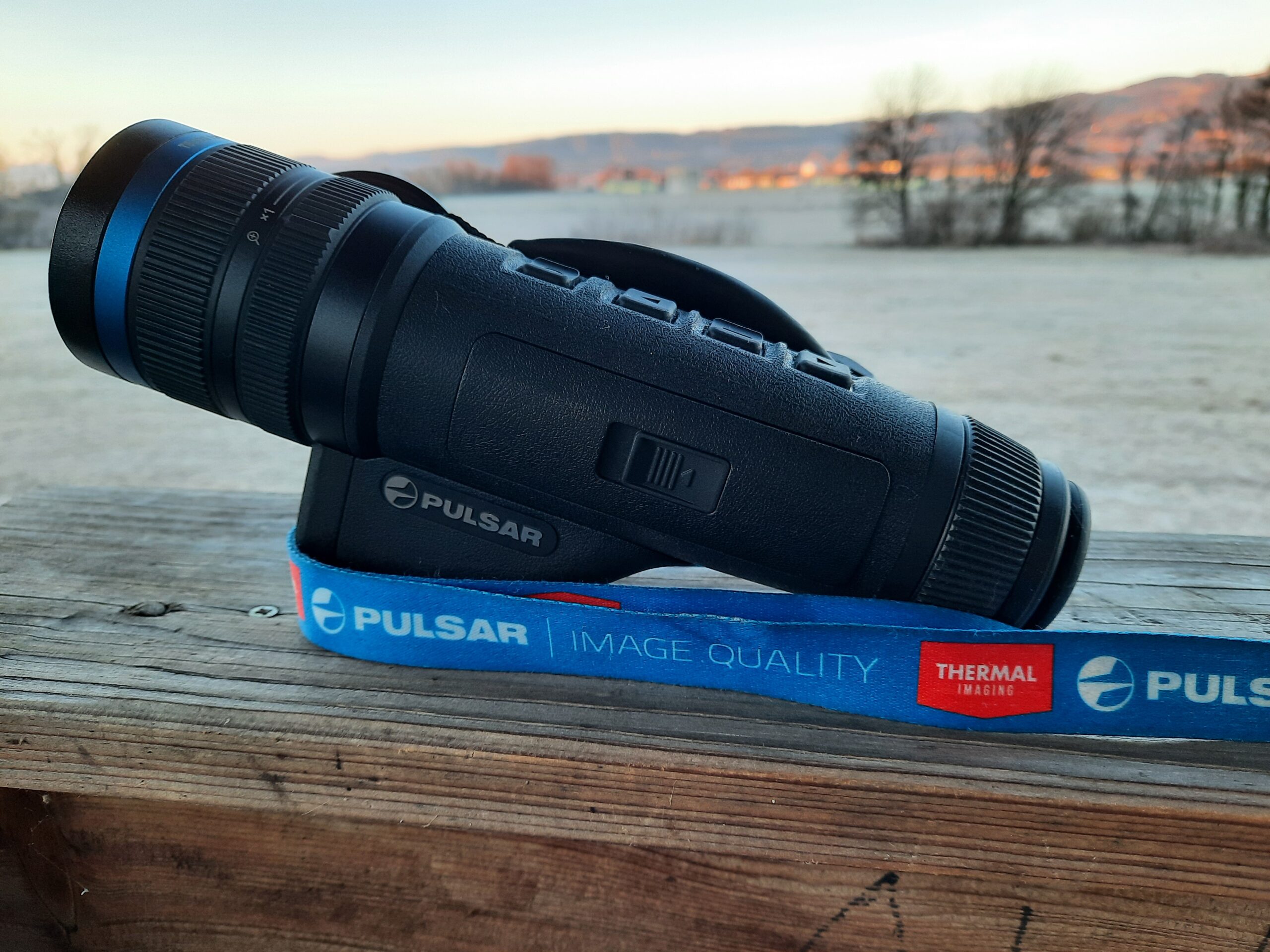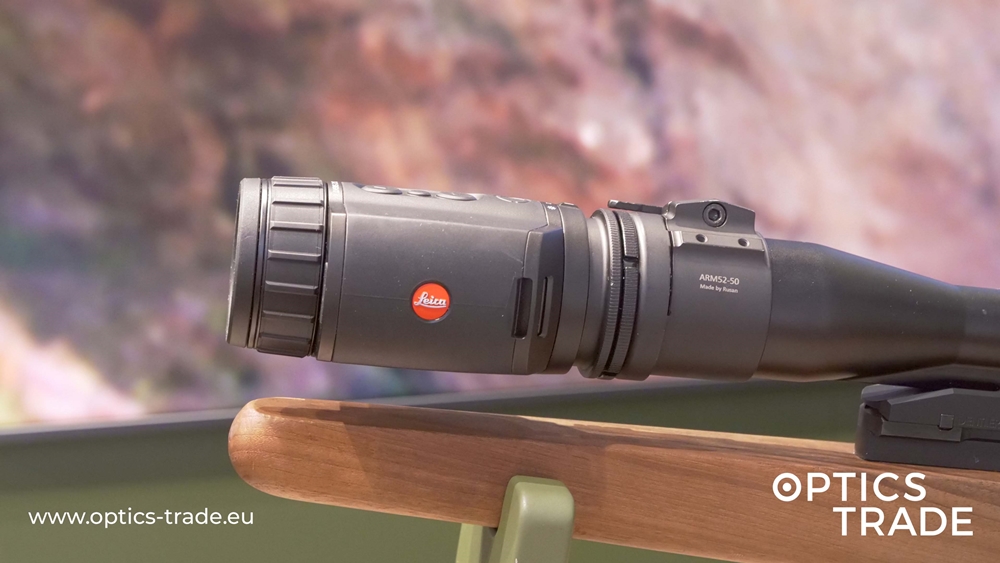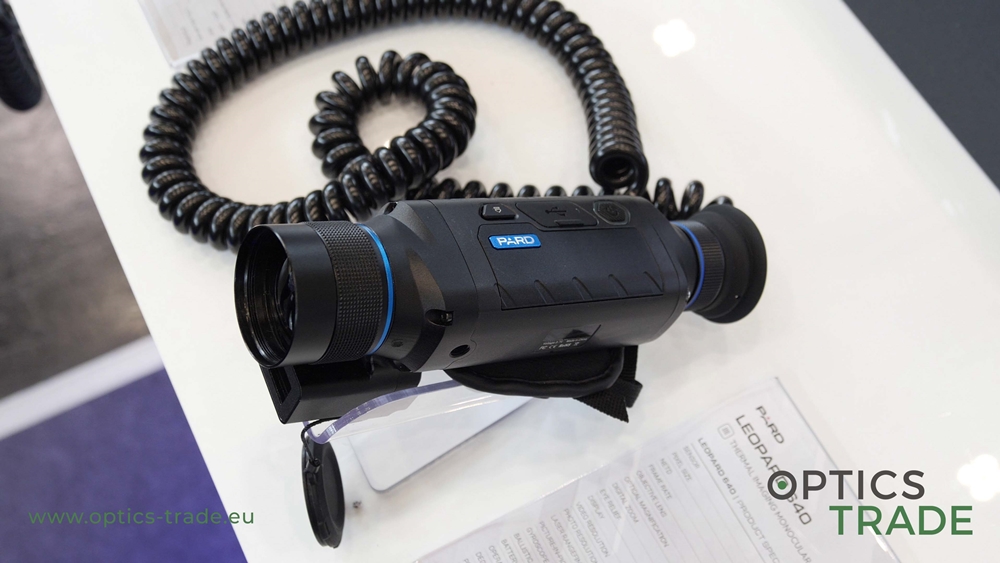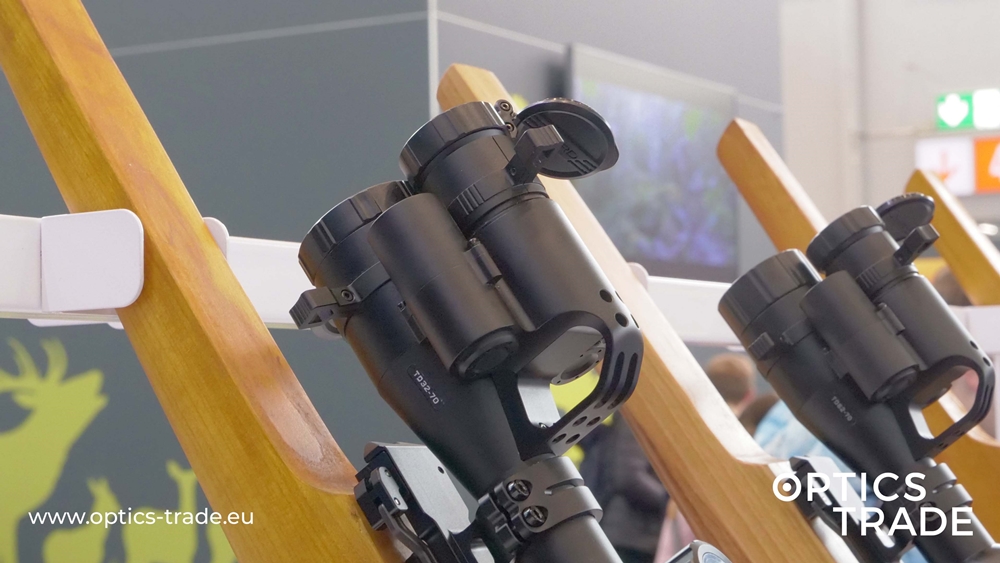In our latest field test, we have tested out Pulsar’s latest premium thermal imaging monocular, the Telos XP50LRF. Those familiar with Pulsar’s thermal imaging monoculars have seen Telos as an updated version of the Helion XP50 Pro, with the option of an integrated laser rangefinder. However, at the presentation of Telos at this year’s IWA 2023 fair, Pulsar introduced the main novelty of the option for later upgrades to the purchased device. Thus, with Telos, it will be possible to replace the sensor, lens, screen, and some electronic components when more powerful ones become available than those in the base model, or to add an LRF module.
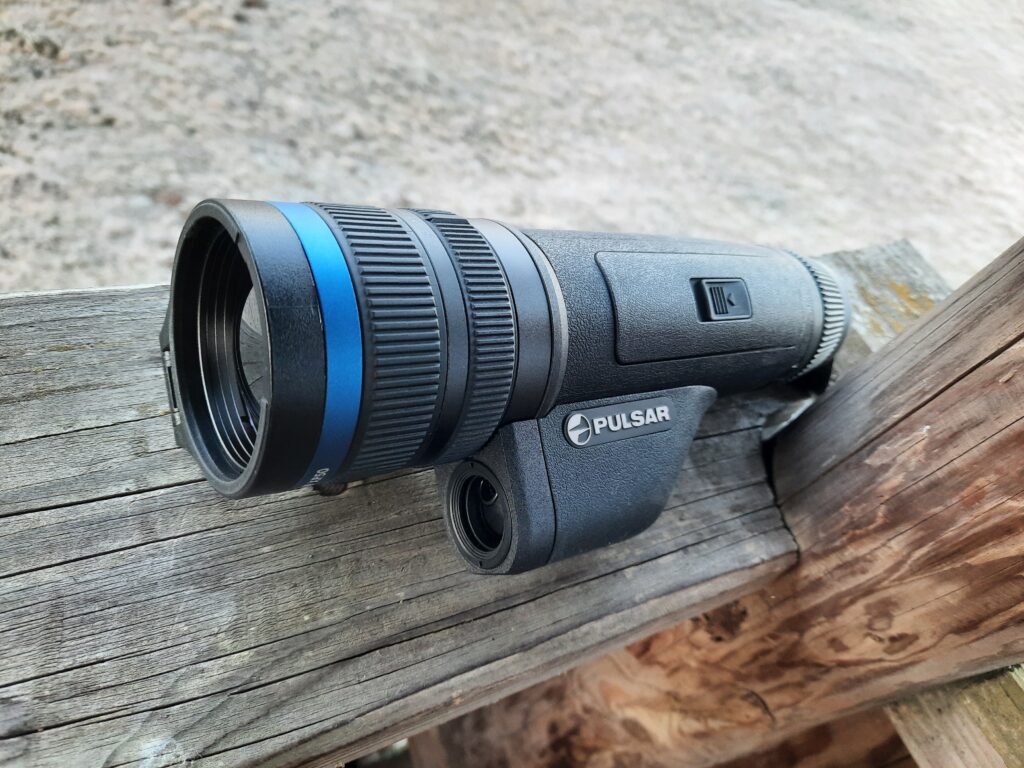
Such a design is something new, and time will tell how it will work and, above all, how many Telos owners will prioritize upgrading their devices over buying an entirely new one. However, our main interest in the test was how the model, offered by Pulsar at the beginning of production, would perform.
Technical Specifications
The Telos XP50 LRF model is equipped with the well-known Lynred sensor with a resolution of 640×480 and a pixel pitch of 17 µm. A novelty that sets Telos apart from its predecessor is the thermal sensitivity (NETD) of the sensor, which is an exceptional <18 mK. This high-quality sensor is paired with a Germanium lens with a focal length of 50 mm and a fast f1.0 aperture. The image is displayed on an AMOLED HD screen with a resolution of 1024×768 pixels. Pulsar only incorporates a larger screen into the Krypton 2 series of front thermal imaging attachments, which is logical, as with increased optical magnification in rifle scopes, we bring the screen image closer and thus reduce its resolution.
| Telos XP50 LRF | |
| Sensor | 640×480 pix. 17 µm NETD <18 mK |
| Lens | F50/1.0 |
| Magnification | Optical 2,5x Digital 4x |
| Field of view | 12.40x9.30 21.8mx16.3m/100m |
| Detection range | 1800m |
| Display | AMOLED HD 1024×768 |
| Power | LPS7i Li-ion Battery Pack Operating time up to 8,5h USB – C |
| Dimensions | 238x72x90 mm 580g without battery / 720g with battery |
| Protection | IPX7 -250 do +400 |
| Video/photo recording | Resolution: 1024×768 Format: mp4 / .jpg 64GB internal memory |
| Max. measuring range Measurement accuracy | 1000 m ± 1 m |
Image Quality
From the technical specifications, it is evident that this is a high-class device, as confirmed during testing. The thermal imaging sensor with a resolution of 640×480, a pixel pitch of 17 µm, and most importantly, a very low NETD value of <18 mK, combined with a Germanium lens with a focal length of 50 mm and a fast f1.0 aperture, ensures outstanding image quality with a high level of detail.
The NETD value of <18 mK truly proved its worth in challenging conditions. We had the opportunity to test the device in fog and light rain. In both cases, there are numerous small water molecules in the air, which, on the one hand, limit the spread of thermal radiation from observed objects through the air, and on the other hand, there is a lot of moisture on all objects, equalizing the temperature differences between them. In such situations, thermal imaging devices with a lower NETD value maintain a significantly higher level of detail in displaying the observed object and, especially, the surroundings, where temperature differences are particularly small. As expected, in favourable thermal conditions, the image in the Telos is truly excellent. The displayed objects and surroundings are sharp and full of details that were not commonly seen in commercially available thermal imaging monoculars until now.
With the Telos XP50 LRF, clear identification of wildlife is possible at distances of up to approximately 400 meters, even when the animal is stationary, and only its silhouette is visible. At distances below 100 meters, the display of details is so precise that we can clearly distinguish the gender of roe deer and wild boars, even in the case of a stationary silhouette. In our scenario, the Pulsar Telos XP50 LRF clearly displayed the antlers of a roe-deer buck at a distance of 100 meters, and at a distance below 50 meters, the image of the antlers was clear enough to see the tines, allowing for at least a rough estimate of the trophy’s value. The details of the surroundings were rendered with extreme precision, to the extent that it felt like using a digital night vision device. In the past, using thermal imaging devices in complete darkness made it difficult to determine the location and distance of wildlife from us. Despite the excellent contrast between the animal’s body and the surroundings, the latter was often quite blurred. The Pulsar Telos XP50 LRF, however, accurately outlines various objects in the hunting ground, providing excellent spatial orientation. This allowed us to estimate distances to the target quite accurately, based on our prior knowledge of the hunting ground, but this wasn’t necessary as we had a device equipped with a laser rangefinder (LRF).
Telos allows users to choose from 8 different color palettes for displaying thermal objects: White Hot, Black Hot, Red Hot, Rainbow, Ultramarine, Red Monochrome, Sepia, and Violet. Pulsar recommends specific colours for various observation scenarios and needs when introducing Telos. However, in conversations with users, it is often revealed that they typically choose between the White Hot and Black Hot options. The choice of colour mode for thermal imaging devices depends heavily on individual habits and personal preferences. Therefore, it is usually avoided to advise on which colour an individual should choose, as they can determine this through experience with the device. However, selecting the appropriate colour palette is one way to reduce the loss of night vision that occurs when using night observation devices. Night vision loss is particularly troublesome when we have a night observation device (thermal or digital) only for observation, and we must shoot through a conventional riflescope with the help of moonlight, snow, or ambient light. To mitigate this issue, we can choose a colour palette that is least burdensome for the eyes while enabling good detection and recognition of the observed object. In our case, the choice of White Hot proved to be the most suitable, covering most of the screen with a darker background representing the colder surroundings. If needed, we quickly selected Black Hot for better detection, but we did not use other colour combinations. However, they are available to the user, and with some practice in using the thermal imaging device, each individual will quickly determine which colour suits him best.
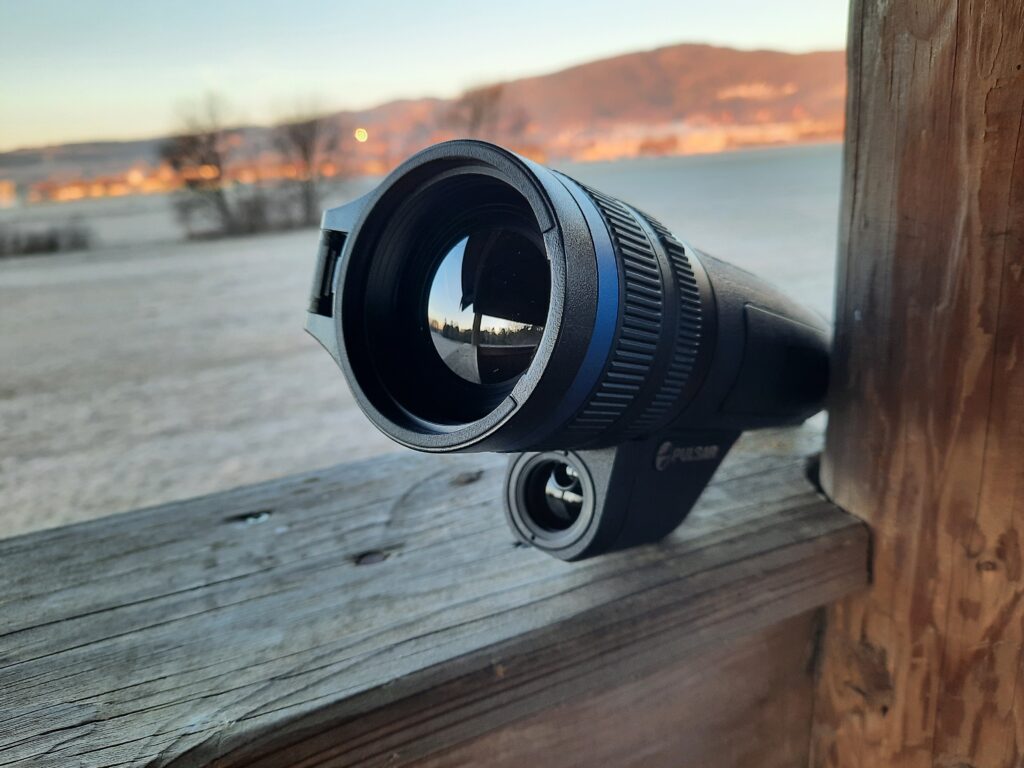
The quality of the displayed image is, of course, greatly influenced by the thermal imaging device’s screen. The Pulsar Telos XP LRF is equipped with a large AMOLED screen with a resolution of 1024×768 pixels. This large screen complements the wide field of view captured by the device’s thermal sensor. It is comfortable for the eyes and not tiring. However, there are still faint grey lines on the screen and in the device’s video recordings, forming a thin transparent curtain, which apparently remains a distinctive feature of Pulsar’s thermal imaging devices. This feature is less noticeable in Telos than in some older and cheaper Pulsar devices. Over time, users become quite accustomed to such an image, and it is no longer distracting, especially when using the Black Hot colour mode, which somewhat conceals the grey lines within the predominantly brighter background of the image.
To ensure that the device displays a truly sharp image, it is necessary to regularly use the image focus button at different distances. The depth of field in thermal imaging devices is not particularly large, and if a detailed and sharp image of the observed object is desired, the image must be frequently focused. Due to the technical sophistication of the Telos XP50 LRF device, during our test, it often happened that we were satisfied with the thermal image without realizing that the image was out of focus. It took some time for us to get used to using the image focus button more frequently and thus enjoy a genuinely sharp image. The device allows for up to 4x digital zoom, which, when combined with the basic 2.5x magnification, provides a total zoom of 10x. Of course, using digital zoom results in a pixelated image, but with Telos, this is not too bothersome up to around 6-8x total magnification. Only when approaching the final 10x total magnification does the image become too pixelated. The so-called continuous zoom mode worked very well during digital zoom. Using the zoom ring, we could increase the magnification by 0.1x increments instead of the usual whole steps of 2x, 3x, and 4x. This allowed us to precisely adjust the magnification to the desired image size, considering the degree to which the image quality deteriorates. Most of Pulsar’s current thermal imaging devices offer a three-step adjustment of the thermal signal gain (normal, high, ultra).
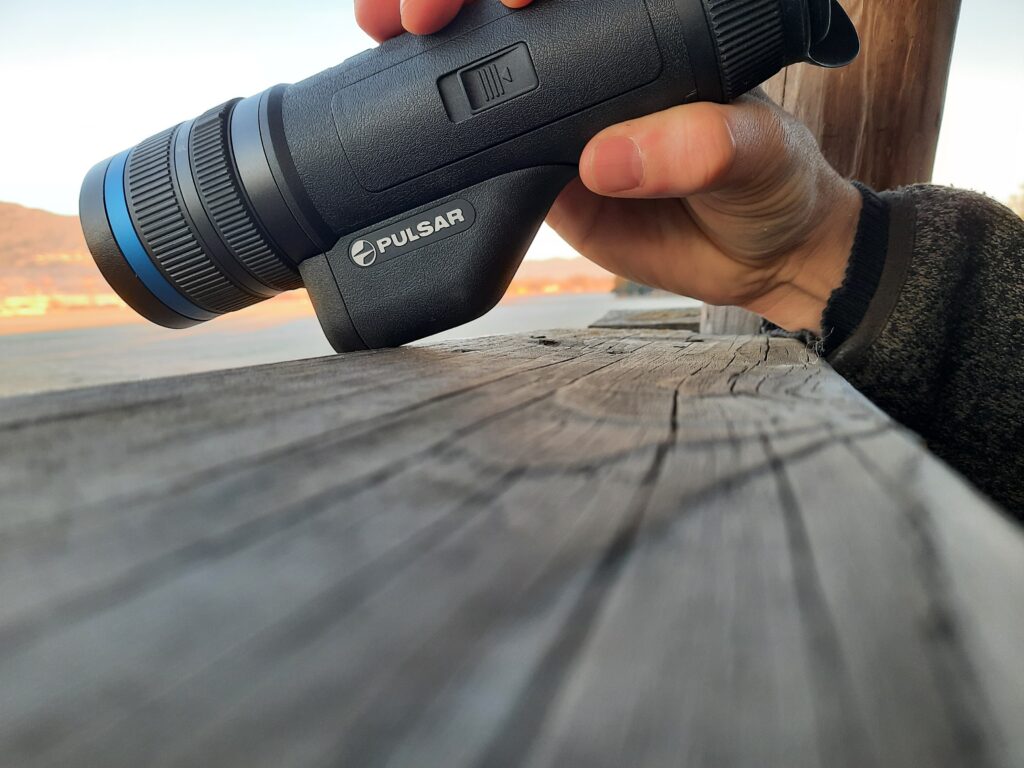
In past tests of Pulsar devices, we found that, in normal conditions, the basic (normal) setting provides the best image. In this setting, the image offers the most details of the observed object and its surroundings. We only used signal gain in foggy conditions when the thermal image already has fewer details, and signal gain allowed the detection of warm objects at slightly longer distances. Another function intended to improve image quality is the so-called Smoothing filter, which we turned off after brief testing. In our opinion, this filter makes the image less sharp, and we couldn’t find a meaningful use for this function.
Device Ergonomics
The ergonomics of the Telos XP50 LRF are designed so that users can equally use the device with either the right or left hand. All control buttons are located on the top of the device, easily accessible from both sides. Unlike the Axion 2 LRF devices, where the laser rangefinder on the left side of the device complicates use with the left hand, the LRF module on the Telos does not hinder the grip of the device. The image focus ring at different distances is located at the usual place at the end of the lens. A novelty in the Telos is the ring for adjusting digital zoom. It is positioned just behind the focus ring and somehow attempts to mimic the rings for adjusting magnification on zoom camera telephoto lenses. This solution seems quite successful, especially in conjunction with 0.1x increments changes in digital zoom. Using buttons in such a mode would require too frequent pressing to achieve the desired zoom. By turning the zoom ring, we can quickly and precisely set the desired magnification. However, this method of changing the zoom also has its drawbacks. The most obvious is that we need to hold the device with both hands and, of course, release all the other equipment we use for hunting. For those who hunt using a shooting stick, the rifle is usually leaned on the stick during observation, and they will now have to move it to the shoulder to use the Telos zoom ring. Turning the zoom ring also causes a bit more image shake than pressing the usual zoom buttons. This is noticeable mainly when recording a video and wanting to capture the process of zooming in the video.
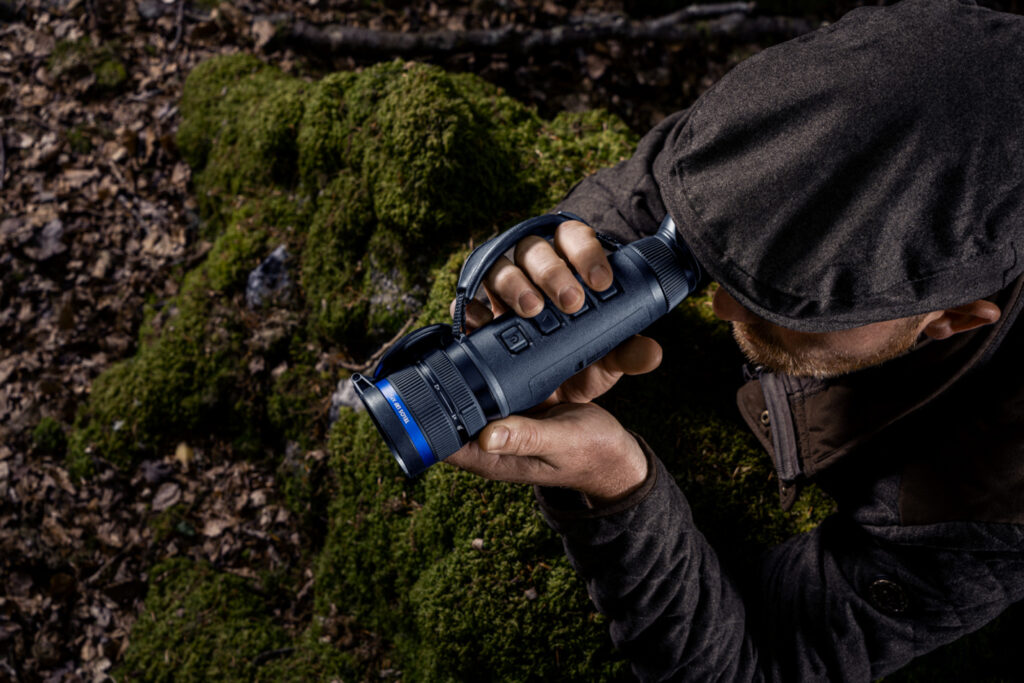
Regarding the size and weight of the Telos XP50 LRF, it must be noted that it is a considerably large monocular. It is by no means a device that can be carried in the pocket of a hunting jacket, like, for example, the monoculars in Pulsar’s Axion series. When used alongside a traditional hunting scope, one of the two devices will almost certainly be in the way and need to be set aside. Whether it was really necessary to incorporate all the components into such a large housing for such a technically sophisticated device is a question for Pulsar’s engineers. During our test, we focused on the strengths and weaknesses of the Telos design. Excessive size is typically considered a negative characteristic in hunting equipment, but not always. Due to its size, the Telos can be held with both hands, providing a more secure and stable grip than holding a small device with one hand. It also has more surface area for support when using the edge of a hunting blind during observation in the surrounding environment.
Build Quality
The build quality at Pulsar has never been questionable, which is certainly reflected in the Telos as well. Instead of magnesium alloys, composite polymers coated with rubber have been used for the Telos housing, providing users with a more comfortable grip, especially in colder weather without the use of gloves. This design reduces the likelihood of accidentally dropping the device and minimizes the sound in case of a potential impact between the Telos and other hunting equipment. Damages on the surface of the housing are less visible, and dirt is easier to remove, helping to keep the device in good condition. From our test, we can confirm that the grip and tactile feel of the Telos are indeed very pleasant during use.
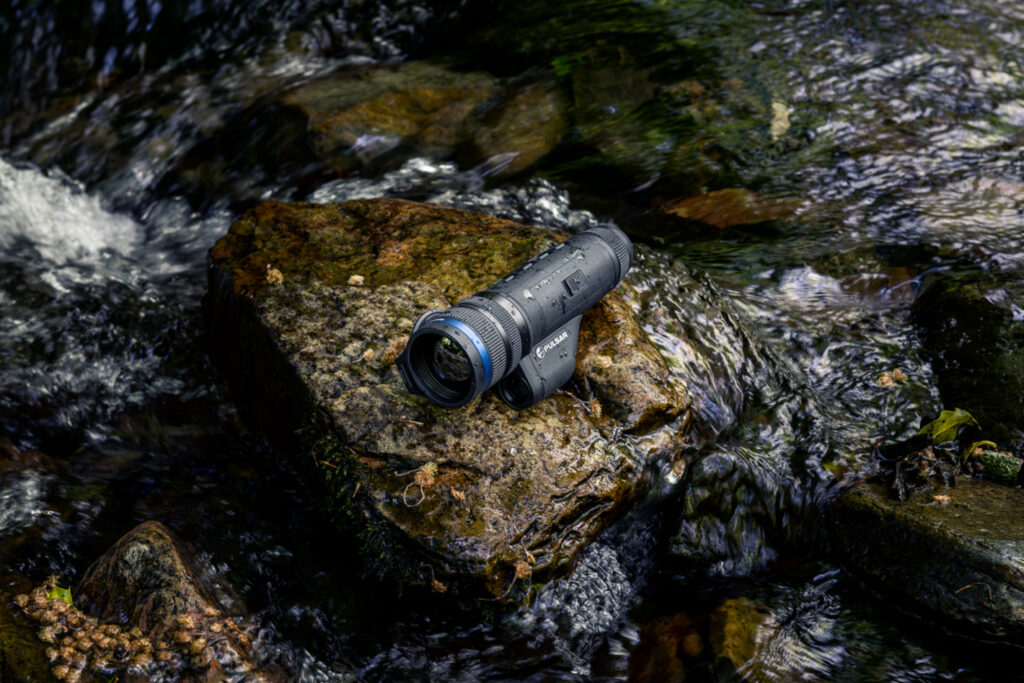
The Telos housing is designed in a way that no unnecessary parts protrude, except for the LRF module in the LRF model, of course. Even with the intensive use of the LRF model, we did not notice any issues with the monocular getting stuck among other gear or clothing. The implementation of the hand strap on the Telos is well executed. This hand strap can be moved to the left or right side without the need for removal or detachment, allowing users to adjust it according to their preferred way of holding the device. The Telos is completely waterproof according to the IPX7 standard and can operate in temperatures ranging from -25 to +40 degrees Celsius.
Laser Rangefinder (LRF)
The Pulsar Telos XP50 LRF is equipped with a laser rangefinder capable of measuring distances up to 1000 meters with an accuracy of +/- 1 meter. The use of a laser rangefinder in thermal imaging devices is beneficial, especially during night-time use. At night, the characteristics of the environment are less visible because the field of view of night vision devices, regardless of their quality and technical specifications, is still significantly narrower than observing the surroundings with the naked eye. It often happens that only the observed object is visible in the device’s field of view, without any reference objects to estimate the distance. Knowing the distance is particularly helpful when shooting at longer ranges, especially when using calibers with a flatter bullet trajectory, aiding in making a fair and accurate shot on the game.
During the test, the laser rangefinder on the Telos worked without any significant issues related to potential technical malfunctions of the device. In conditions where there was a lot of moisture in the air, the rangefinder occasionally did not display the measured distance and instead showed a distance of 8 meters, regardless of where it was aimed. However, such limitations in the operation of laser rangefinders in very humid atmospheres are known with other manufacturers as well, and they were somewhat expected. For future users, it’s important to be aware of certain specificities that may arise when using the laser rangefinder due to the placement of certain ergonomic solutions on the device.
The Laser Rangefinder (LRF) module is located on the bottom side of the monocular, slightly behind the focus and digital zoom adjustment rings. Due to the size of the Telos, the user is likely to use both hands when observing, with the front hand holding the zoom ring and thereby completely covering the laser rangefinder module. When the user wants to use the laser rangefinder, they must consciously grip the device and ensure that their hand does not block the laser beam. Typically, in such a case, the monocular is held with only one hand or the supporting hand is moved behind the laser rangefinder module.
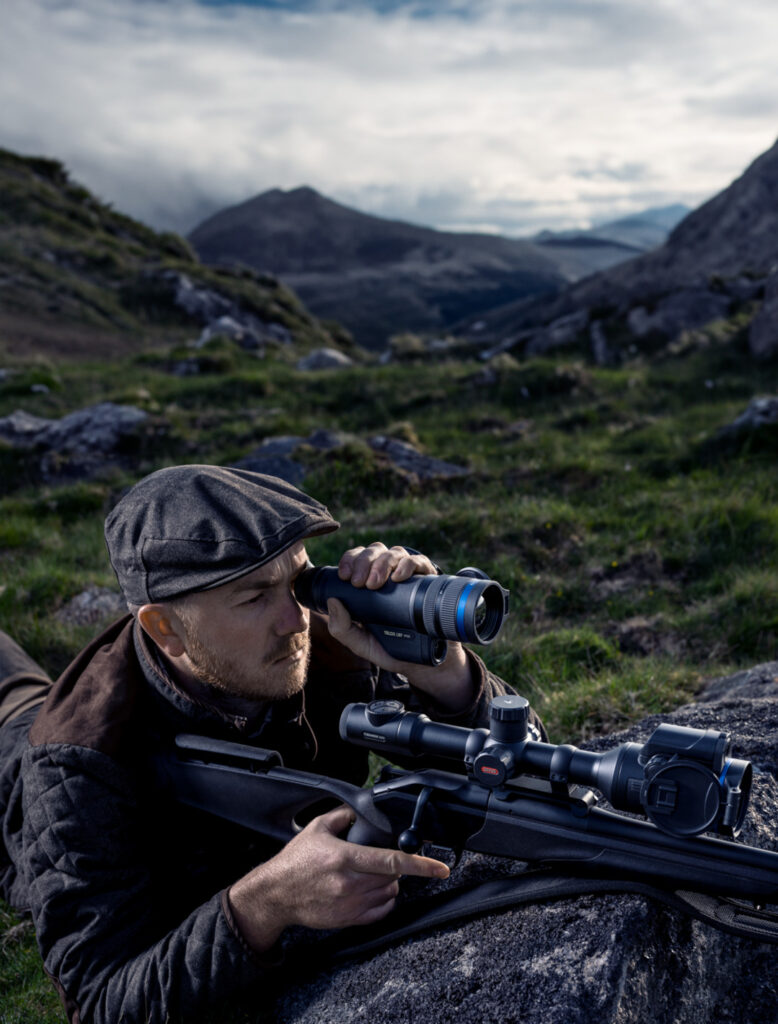
Another situation where unintentionally blocking of the laser beam occurred was during observation from a hunting blind. To stabilize the image, the Telos was usually leaned against the edge of the blind. When observing objects at a shorter distance, the front part of the device had to be tilted downward, causing the laser rangefinder module to be blocked by the surface on which the Telos was leaning. In these cases, as well, users had to learn from their mistakes and be conscious that when measuring the distance from a height at a vertical angle, they needed to ensure that the LRF module’s beam had a clear path to the target.
The laser rangefinder module allows for two distance measurement modes: a single measurement initiated by pressing the LRF button (the first button on the rear of the device) and the option for continuous sequential measurements (SCAN). During a single distance measurement, it’s important to note that the first short press of the LRF button activates the LRF module. A small square appears on the main screen to guide the laser beam to the target, and a picture-in-picture window appears in the middle of the upper edge of the screen. Actual single measurements are then carried out with each subsequent short press of the button. To enable continuous distance measurement, press and hold the LRF button while the LRF module is still active.
During the use of the Telos, it was observed that distance measurements in continuous mode are more precise and consistent than with single measurements. This observation is attributed to the relatively firm buttons that require a decisive press. The device usually moves at least a little during this process, potentially shifting the measurement point close to the target rather than directly onto it. Therefore, it is recommended that users activate the SCAN function when using the laser rangefinder. They can then stabilize the square for directing the laser beam to the target and wait for the device to read two to three consecutive measurements. In this case, the measured distances never differed by more than +/- 1 meter, which is entirely sufficient for hunting needs.
Battery
The Pulsar Telos uses the LPS 7i battery, a new model that has not been integrated into other Pulsar devices before. The battery has a capacity of 6400 mAh and is expected to provide 8.5 hours of device operation. During use in hunting conditions with average temperatures ranging from 50-00 degrees Celsius, the battery lasted approximately 7 hours. This duration included frequent use of the laser rangefinder and adjustments to various settings. Users need to assess whether around 7 hours are sufficient for their hunting outings, or they may choose to purchase an additional LPS 7i battery just in case. A notable feature of the battery is that it doesn’t require a special charger. It has a built-in USB-C input, allowing users to charge the battery with any standard USB-C charger. Charging is also possible through the USB-C input on the device’s housing.
Included Accessories
When purchasing the Pulsar Telos XP50 LRF thermal monocular, the buyer receives a soft carrying case, a strap for the case, a lens cloth, and a USB cable. The package also includes protective covers for the battery compartment and the battery itself. Quick user instructions for operating the device and guidelines for the Stream Vision 2 application are provided. While the case is useful for protecting the device during transport, it may not be suitable for carrying during hunting as it is too large and cumbersome. It’s worth noting that for a device of this high class, an included neck strap (Pulsar single-point neck strap) would be a valuable addition, and buyers are encouraged to consider it as an additional purchase. Given the price of the Telos, including the neck strap in the basic equipment would be a reasonable expectation.
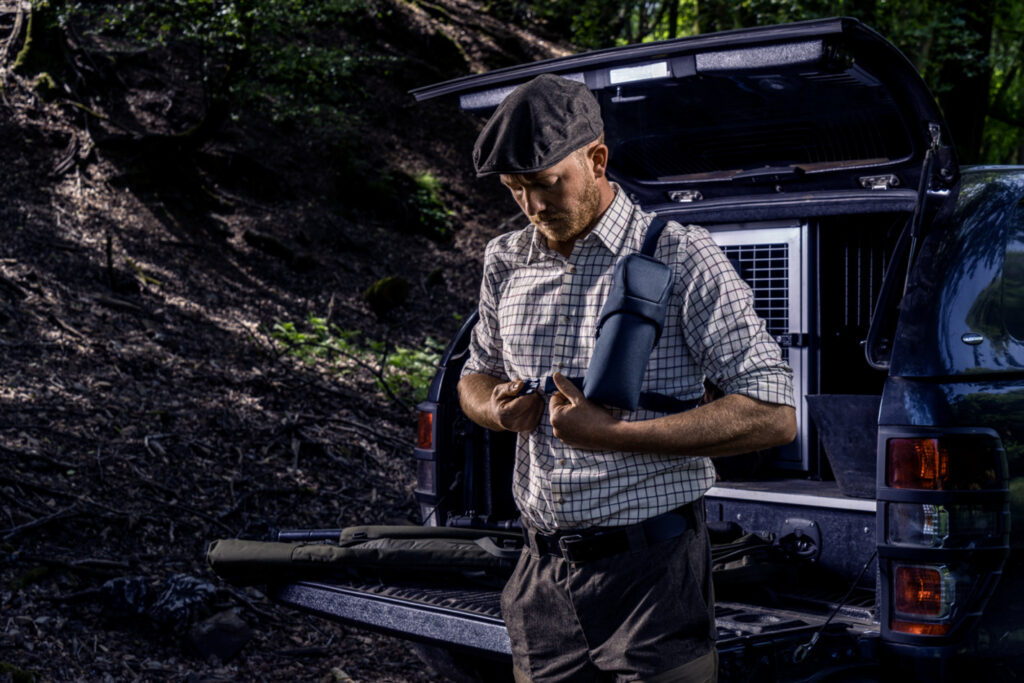
Connectivity
The well-known Stream Vision 2 application worked seamlessly with the Telos, indicating that Pulsar has successfully addressed stability issues present in the initial version of their application. The connection to the device functioned well in all conditions. Even in environments with multiple available WIFI networks, the connection between the smart device (phone, tablet) and the Telos remained stable. The application allows for transferring photos and videos, remote control of almost all device functions (except for focusing and image zooming), and receiving software updates. Of course, photos and videos can also be transferred via the included USB cable, with the device appearing as a removable storage medium on the computer.
Conclusion
The Pulsar Telos XP50 LRF is an outstanding thermal imaging monocular that displays night-time activities in the hunting ground with exceptional thermal imaging quality. The device is recommended, especially for hunters who spend most of their time hunting at night, where conventional binoculars are not necessary. Those who prioritize top-notch image quality over the slightly larger dimensions of the device will also opt for the Telos. However, it’s not a device designed solely to complement a conventional binocular during daily patrols in the hunting ground. For such purposes, Pulsar has the Axion series of monoculars, which, with slightly lower technical specifications, compensate with exceptional compactness and convenience.
This is perhaps the only significant criticism and room for improvement that can be attributed to Telos. The fact is that modern thermal imaging devices can already provide such a high-quality image that further improvements will become increasingly challenging, and users will demand greater compactness and convenience. Apart from this, it can be confidently stated that Pulsar has succeeded in pushing the already exceptional features of the Helion 2 XP50 PRO even higher with the Telos. The image quality of the Telos thermal imaging can currently only be matched by Pulsar devices with an XL sensor, and even then, only in favourable thermal imaging conditions. In the toughest conditions, such as fog, heavy snowfall, or intense rain, the Telos excels, thanks to its outstanding NETD of <18 mK.
